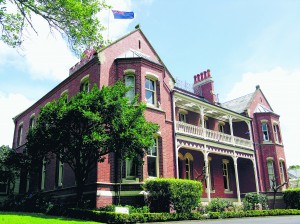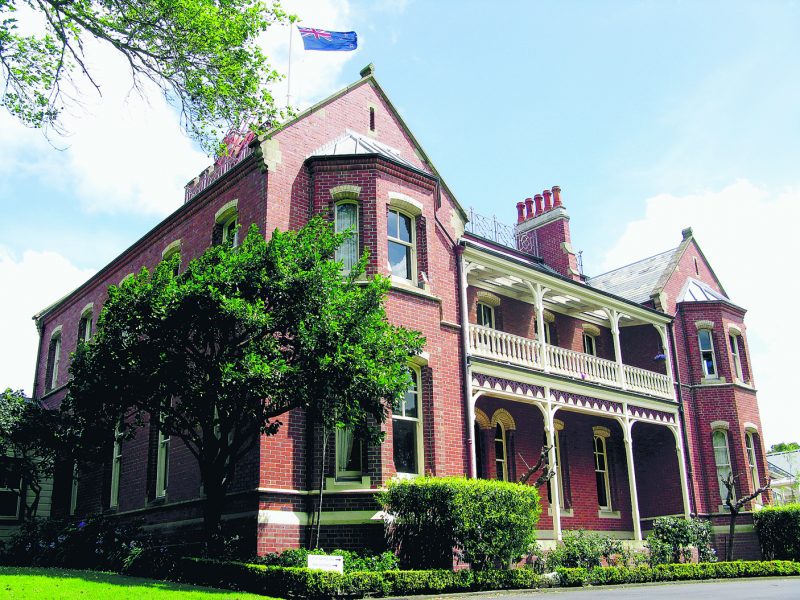by NZ CATHOLIC staff
AUCKLAND — The historic importance of two Auckland Catholic landmarks has been recognised.
The NZ Historic Places Trust recently registered Bishop’s House in Ponsonby, and St Benedict’s Church and presbytery, as Category 1 historic places, identifying them as places of outstanding heritage significance.
The Historic Registration Adviser for the trust, Martin Jones, said of Bishop’s House that, as well as its commanding presence, the brick building — which has served as the Catholic Bishop of Auckland’s residence for almost 120 years — has significant architectural claim to fame.
“Its design was heavily influenced by Augustus Pugin — one of the ‘Godfathers’ of the Gothic Revival style of architecture that swept Britain and many other parts of the world in the 19th century,” Mr Jones said.
“The architect’s son, Peter Paul Pugin, designed Bishop’s House, drawing inspiration from The Grange in Ramsgate, which had been created by his father, Augustus, as his own home. The Bishop’s House is a rare 19th century example of a Catholic bishop’s residence and, as a Peter Paul Pugin design, likely to be unique in New Zealand.”
Mr Jones said St Benedict’s was completed in 1888 following a fire that destroyed the original church building.

Bishop's House in Auckland is bounded by New St, St Mary's Rd, St Frances de Sales St and Green St in Ponsonby.
“The church was built on what the NZ Herald described as ‘the highest ground about the city’ in response to the rapidly expanding settlement in the south and west of Auckland — providing an important centre for the parish of St Benedict’s, which in the early 1880s comprised up to 2000 people.
“Before the fire, St Benedict’s had a greater number of communions every week than St Patrick’s,” he said.
St Benedict’s was the headquarters of the first Benedictine mission in New Zealand. “St Benedict’s Church and presbytery was unique in this country in that it was founded from the Subiaco monastery in Italy — a major centre for the Benedictine revival — and also Subiaco’s daughter establishment of St Augustine’s Abbey in Ramsgate, England,” he said.
“During the 1880s, Benedictine fathers made up about half of the Catholic priests in Auckland diocese.”
The St Benedict’s design was initially intended to include elaborately traceried windows, external mouldings and a spire-less tower. However, the final design was stripped of much decoration and kept simple in accordance with its Benedictine monastic roots, which espoused simplicity and austerity.
The design did, however, retain a strong Gothic Revival appearance.
Like Bishop’s House, the style was championed by English architect Augustus Pugin.
“The end product embodied the notion of ‘honesty of construction’ in which a building’s practical usage and construction materials should not be concealed,” Mr Jones said.
“The result is a building that has a ‘what you see is what you get’ practicality to it — right down to its former crypt, said to incorporate basalt walls from the original church. In its simplicity, the building may have been especially influenced by the Benedictine Church of St Augustine at Ramsgate Abbey, which has been regarded as Pugin’s final masterpiece.”
Importantly, in terms of its connections with Auckland, St Augustine’s was also the church from which many of New Zealand’s Benedictines — including the serving Bishop of Auckland, John Edmund Luck — were sent.
Bishop Luck’s father had bought The Grange in Ramsgate, so the bishop was acquainted with the Gothic residence. It seems he was keen to capture some of The Grange’s architectural style and presence in the new Bishop’s House.
That building was commissioned by Bishop Luck, who raised funds for its construction during a tour of Europe in 1891-92. “The foundation stone was laid in May 1893, and Bishop Luck took possession on Easter Sunday almost a year later,” Mr Jones said.
“Perhaps one of the most striking features of Bishop’s House is the high, crenellated tower which provides a stunning view of the Mount St Mary and Freemans Bay areas as well as Waitemata Harbour. The Grange also has a similar tower.”
Bishop’s House included a series of state-of-the-art gas burners, complete with patent electrical mechanisms for lighting and extinguishing gas lamps. Bishop Luck bought the hardware as he passed through the United States. The installation was believed to be the only one in Australasia at the time.
Another innovation was the freestanding “Unitas” toilet, initially designed by Thomas William Twyford of Staffordshire. Advanced for its time, the one-piece design helped make the exposed pedestal toilet acceptable.
The building also incorporates the first experimental use of Matamata stone (Hinuera Ignimbrite) in New Zealand.
Today, Bishop’s House is linked by two glazed cloisters to the Pompallier Diocesan Centre — the administrative headquarters of the Catholic Diocese of Auckland, which was completed and opened in 1989.
“The house continues to be used as a Bishop’s residence, a tradition established on the site by Bishop Jean-Baptiste Pompallier, whose wooden house was relocated a small distance to St Marys Rd when the current building was erected, and which was registered as a Category 1 historic place by the trust last year.”
Next to St Benedict’s, the presbytery — or, more accurately, monastery — was built in 1888, also to a Gothic design intended to complement the church.
In 1894, the St Benedict’s Club was established for ‘the social amusement of the Catholic young men in the parish’. It was also envisaged that a clubroom would be created where members would be able to assemble to “read papers, books etc or else indulge in chess, draughts and similar games”.
In about 1919, a freestanding brick building was added to the complex to house the club’s activities.

Reader Interactions